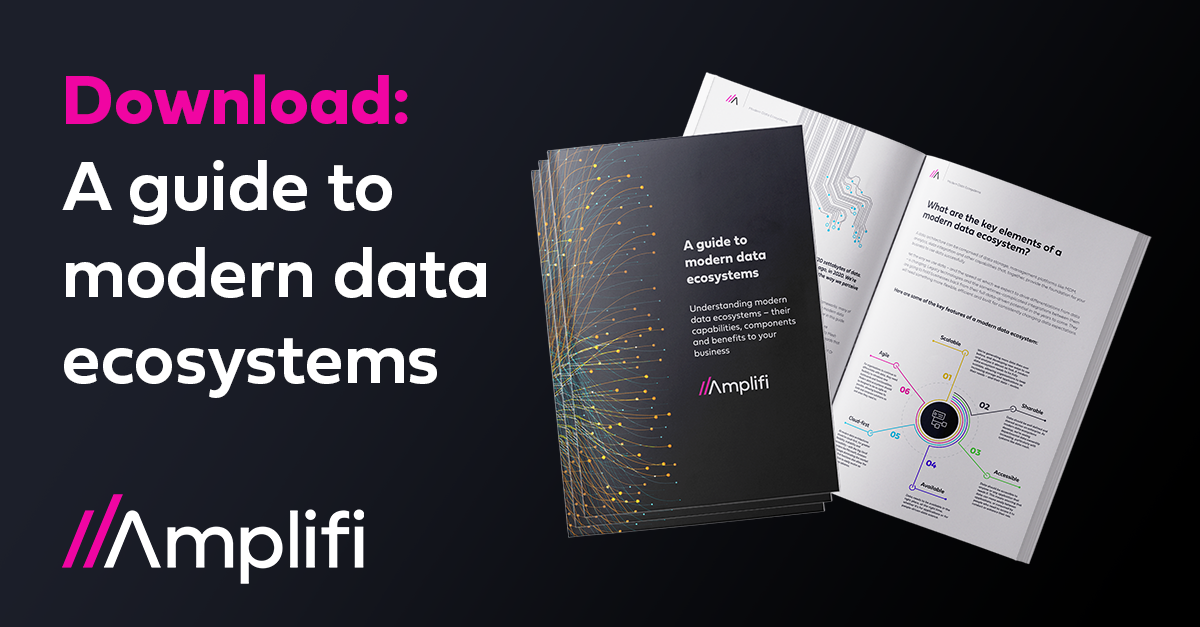In the first in a new series, Amplifi examines the key elements of a modern data ecosystem and how to introduce them to your enterprise.
For years, organizations have looked to implement solutions, platforms, and approaches that help them to get value from their data. From Master Data Management (MDM) platforms to analytics, enterprises have been adding data capabilities that fulfill specific data-related needs. Yet today, businesses are moving away from thinking about their data platforms as siloed solutions, and are starting to look at how they integrate in the bigger picture. It’s a trend towards considering the entire data ecosystem as one whole, rather than disparate systems working in tandem.
However, while this might be a new and exciting approach, it doesn’t mean you have to throw away everything you already have and start from scratch. Instead, you need to frame your data capabilities as part of that ‘bigger picture’, thinking carefully about you evolve those capabilities into a truly modern data ecosystem.
Sometimes that evolution is gradual: a small change to our technology stack, a shift in governance. At other times it’s more dramatic, with new ideas emerging that redefine how we think about our data and what we need from the ecosystem that supports it.
 Right now, our expectations for data are accelerating at break-neck speed – as is the sheer volume of data we’re generating. The world will produce an estimated 120 zettabytes of data this year: a number so vast it seems almost meaningless, yet the meaning we can extract from that data is more valuable than ever. New advances in data and analytics are opening incredible opportunities for enterprises – if they can manage and process that data effectively.
Right now, our expectations for data are accelerating at break-neck speed – as is the sheer volume of data we’re generating. The world will produce an estimated 120 zettabytes of data this year: a number so vast it seems almost meaningless, yet the meaning we can extract from that data is more valuable than ever. New advances in data and analytics are opening incredible opportunities for enterprises – if they can manage and process that data effectively.
As a result, it can seem as though more drastic changes to your data architecture are necessary, with new ideas and approaches emerging that promise to provide revolutionary new frameworks that will enable you to better organize, manage, access, and utilize the data that’s available to you.
Yet do these changes need to be as dramatic as you think – or is the reality much simpler and more achievable?
Data Mesh and Data Fabric are two well-defined, if still developing, approaches to creating a modern data architecture that you will have already heard of, and may already be exploring. Yet to adopt these ideologies – or any other method of modernizing your architecture – you don’t need to overhaul your existing ecosystem and start again. These aren’t technologies that you buy into: they are approaches. They define how you approach your architecture, organization, and culture, and can often be introduced by enhancing and adding to technology stacks you already have or changing the way you operate it.
They are also not the only options. A modern data ecosystem can be any combination of approach and technology that works to deliver your organization’s data goals – although there are some key elements that define a ‘modern’ data ecosystem in today’s landscape.
 Key elements of a modern data ecosystem
Key elements of a modern data ecosystem
Exactly how you compose your ecosystem is, ultimately, up to you – but there are some key elements that create what we consider to be a ‘modern’ data architecture today.
Scalable: you should be able to keep increasing and adapting storage and applications as your needs – and your data – evolve.
Sharable: Data should be well-defined and shared across an enterprise – but domain-oriented data ownership is also increasing in modern ecosystems.
Accessible: Data should be able to move easily between source and consumer in your ecosystem, making it accessible wherever it is needed. It should be simple for people and applications to discover, interpret and utilize.
Cloud-first: cloud-first platforms allow for greater flexibility, scalability, and accessibility, and for more seamless evolution as your needs change.
Agile: any modern data ecosystem should be designed to be as agile as possible, allowing you to build and compose solutions when you need to, and promoting self-service for data consumers and developers alike.
The approach, the technology stack, and the operating model will vary from organization to organization, but these principles are core to any modern data ecosystem. Exploring these concepts in relation to your own architecture means looking at whether your organization’s existing technology stack, operating model or culture can offer these principles, and what layers need to be introduced to enable you to fully modernize your approach.
In this series, we’re looking at what you really need to create a modern data ecosystem today – breaking down some of the key capabilities your architecture will need to fulfill your goals, looking at the relationship between technology and culture in a modern ecosystem, and looking at what defined approaches like Data Mesh and Data Fabric can bring to your business.
To find out more about what it takes to implement a modern data ecosystem, download Amplifi’s guide to modern data ecosystems, where we cover understanding modern data ecosystems – their capabilities, components, and benefits to your business.


